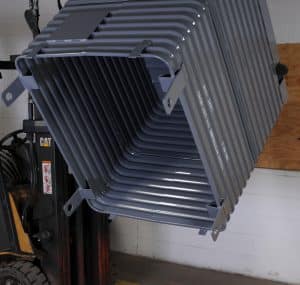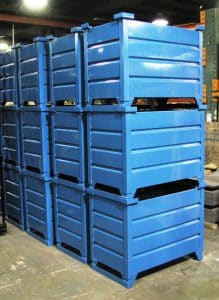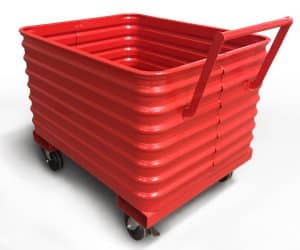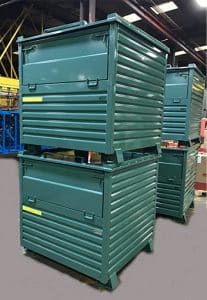Keep Container Movement Safe with These Operating Practices
Posted on Sep 21, 2022
Steel containers used in industrial settings for bulk storage of large parts and for scrap metal can weigh thousands of pounds when loaded, requiring careful handling to protect the containers, their contents, forklift operators, and people near the loads being moved.
“There are a number of factors involved in safe handling of steel containers,” says Craig Heil, Container Sales Manager for Steel King Industries, which manufactures several types of containers sold nationwide.

Rotating container with a fork truck.
Those factors include the construction of the container, the type of forks used to lift and move the container, and how evenly the contents are distributed, Heil says.
“Stability on the forks is the biggest factor at play in safe container transport,” he notes. The operator should know the forklift’s capacity as compared to the weight of the container and its contents, and center the load on the forks. As with any forklift use, the load should be as low as possible when moving.
Fork Tubes, Stirrups Add Stability
Containers, which are also called bins, can include structural fork tubes or fork stirrups. A fork tube runs the entire length of the container, while fork stirrups are welded to the base of the sides of the container. On Steel King containers, the standard opening for each is 8 inches wide by 3 inches deep. That is big enough for forks commonly sold by all manufacturers that range from approximately 1.4 inches thick by 4 inches wide for light duty forks, to 2 inches thick by 5 inches wide for heavy duty forks. For containers that have stirrups, forks should extend from the two stirrups on the entry side through the stirrups on the opposite side.
While tubes and stirrups enhance safe handling of containers, they are not essential. “A container can be lifted with the forks positioned correctly under the container, without the use of fork tubes,” Heil notes.
Forks that are shorter than the container can cause handling problems, as forks are rated for a specified forward center of gravity.
“The length of the forks should be a consideration in safe handling of containers,” Heil says. “If you have shorter forks, the container could apply undue pressure on the ends of the forks, and cause the container to tilt, again causing a safety hazard.”
If handling involves rotating to dump the container’s contents, the compatibility of the forks with the fork tubes is especially important, Heil says. “When maneuvering a container other than lifting or lowering it, you really want to make sure the forks are far enough into the tube or through all the stirrups for safe handling,” he adds.

Stackable bins.
Features Allow for Safe Stacking
Containers, which are commonly about 3.5 feet wide by 4 feet long, can be safely stacked several units high if they are manufactured with stacking features and if material is not overloaded in the container. Steel King containers can be stacked – fully loaded, up to four or six units high, depending on the version being used.
“For stacking containers, make sure that the container is positioned so that it is seated correctly on the stacking plugs or targets, or that the legs are properly seated on the upper ridge of the container,” Heil advises. Those plugs and legs not only support containers stacked atop them, they also provide clearance for the forks.
Movement by Cranes, Casters
When cranes are used to move containers, the connection of the crane sling to the container’s eyes or hooks should be double-checked. Slings should be inspected and replaced if damaged, and the crane operator needs to know the weight of the container load. If your containers have casters, each wheel should be

Wheeled cart with lockable casters.
locked during use. While industrial storage containers might weigh between 200 and 300 pounds empty, they can have a capacity of holding up to 6,000 pounds – depending on the design and construction of a particular type of container. If your containers are intended to hold heavy loads such as the 6,000-pound maximum capacity for Steel King’s Heavy Duty Rigid Containers, heavy duty pallet forks should be used.
While Steel King Industries has standard containers available for quick shipping, the company regularly designs containers for specific needs. “If our standard line of containers is not suitable for a customer’s needs, we’ll design and manufacture just what they need, to ensure safe container handling,” Heil says.

